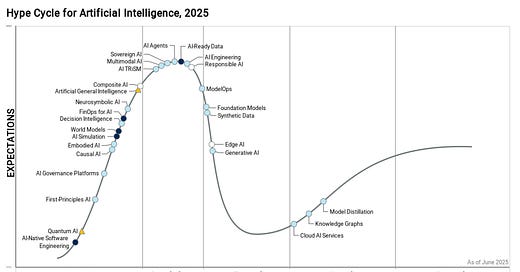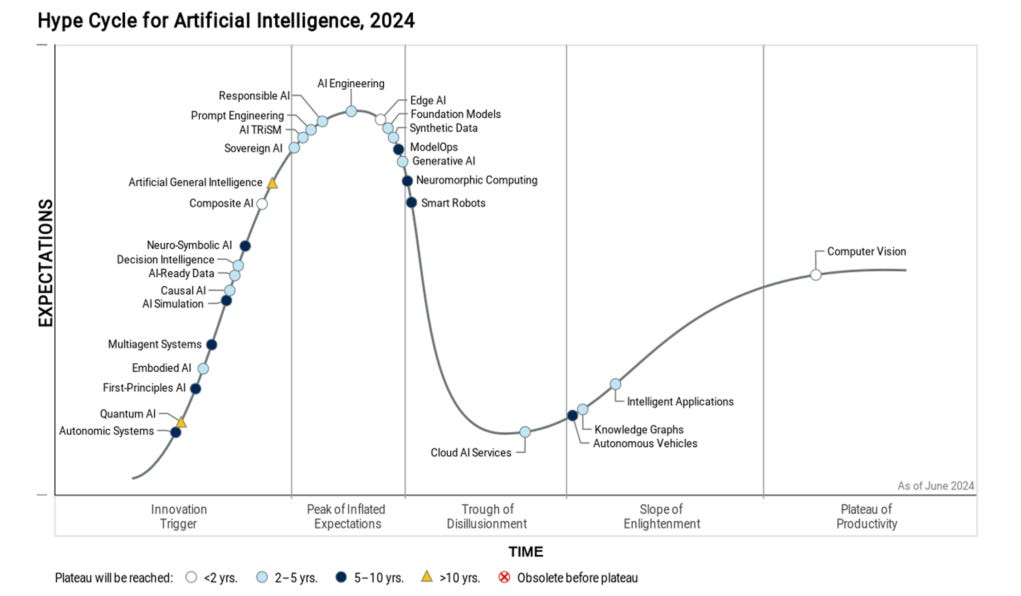Riding the Gartner Hype Cycle: AI in 2025 vs 2024
As generative AI descends into Gartner’s Trough of Disillusionment, organisations must refine strategies, tools and governance to realise real impact.
When Gartner publishes its annual Hype Cycle for Artificial Intelligence, the industry takes note. The 2025 edition, released in June, offers a fresh vantage point on where AI innovations stand—from quantum ambitions to the nuts and bolts of cloud services. By comparing it with the June 2024 chart, we can strip away the noise and see the hard truths: which technologies are real, which are overhyped, and where the next breakthroughs will land.
Image: Hype Cycle for AI, 2024 | Source: Gartner, June 2024
Image: Hype Cycle for AI, 2025 | Source: Gartner, June 2025
From Peaks to Troughs: Shifting Sentiments in One Year
Generative AI’s Descent
2024: Generative AI was perched just past the Peak of Inflated Expectations—its dark-blue marker (5–10 year plateau) signalling that enterprises expected a widespread impact, albeit with a more extended maturation period.
2025: It now sits squarely in the Trough of Disillusionment (light-blue, 2–5 year plateau). Far from a sign of the death knell, this is textbook progression: initial euphoria gives way to the realities of integration, cost, safety and governance.
Foundation Models & Synthetic Data
Both courted extraordinary optimism at the 2024 peak. In 2025, they, too, have slid into the trough—but crucially remain on Gartner’s radar. Their retreat reflects the moment when proof-of-concepts collide with production challenges: model drift, data privacy, and obscure biases.
New Climbers and Fresh Entrants
AI Agents and Sovereign AI now occupy the apex of inflated expectations. Organisations are excited by self-driving assistants and “data sovereignty as code,” but these ideas are equally unproven at scale.
Composite AI (a blend of neural and symbolic methods) and AI-TRiSM (trust, risk and security management) have vaulted into the Innovation Trigger and Peak zones, indicating growing R&D focus on reliability and accountability.
Emerging Realities on the Slope of Enlightenment
Cloud AI Services, Knowledge Graphs, and Model Distillation are climbing steadily. These are the workhorses—tools that enterprises have begun to deploy pragmatically, wringing out measurable value.
Why Generative AI Isn’t Going Anywhere
It’s tempting to read “trough” as “failure,” but this is neither scepticism nor a death sentence. Generative AI’s move into the trough simply signals a transition from wild experimentation to rigorous engineering. Here’s why it remains central to the AI roadmap:
Infrastructure Momentum
Billions of euros have been invested in LLMs, GPUs, and inference platforms. Organisations can’t un-buy this computer, so they’ll optimise and integrate.
Tooling & Ecosystem
An ever-expanding ecosystem of fine-tuning libraries, plugin frameworks and safety toolkits is maturing alongside the models themselves.
Business ROI
Early adopters have already realised gains in content creation, code generation and customer service automation. That business value will anchor generative AI through its growing pains.
Regulation & Governance
As standards and best practices solidify, enterprises will transition from ad hoc experiments to enterprise-grade deployments, transforming hype into complex, deliverable solutions.
What to Watch Next
AI-native software engineering and FinOps for AI are rising on the Innovation Trigger curve: expect new tools for managing costs and versioning of AI applications.
Neurosymbolic AI and Decision Intelligence linger in the early phases; breakthroughs here could redefine explainability and strategic decision-making.
Composite AI’s blend of statistical and rule-based methods may finally crack the code on robustness, pushing it toward the slope of enlightenment.
The 2025 Hype Cycle underscores that AI is at the inflexion point between heady promise and industrial reality. Generative AI’s plunge into the trough is not a setback but a sign of healthy maturation. It’s when we move beyond hype—facing down integration hurdles, regulatory demands and operational scaling—that generative models will truly reshape industries. The following 12–18 months will separate the pilot programs from the production line. Strap in: the real journey has only just begun.





